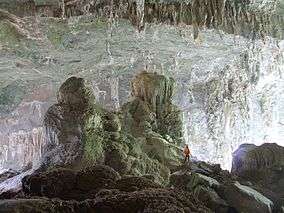Alto Ribeira State and Tourist Park
| Alto Ribeira State and Tourist Park | |
|---|---|
|
IUCN category II (national park) | |
|
Tourist State Park of Alto Ribeira | |
  | |
| Location | São Paulo, Brazil |
| Coordinates | 24°28′30″S 48°39′30″W / 24.47500°S 48.65833°WCoordinates: 24°28′30″S 48°39′30″W / 24.47500°S 48.65833°W |
| Area | 35,712 hectares |
| Established | 1958 |
Alto Ribeira State and Tourist Park (PETAR), is one of the oldest parks in the State of São Paulo, created by decree no. 32,283 of May 19, 1958.[1] With an area of 35,712 hectare between the towns of Apiaí, Eldorado and Iporanga, it lies 320 km from Sao Paulo and has four cores of visitation and support for enforcement activities and research in order to safeguard and protect the rich natural heritage of the upper Ribeira region, represented by the important biodiversity of the remnants of the Atlantic forest and its paleontological, archaeological and historical sites, home to one of the most important speleological provinces in Brazil with more than 300 caves registered by the SBE - Sociedade Brasileira de Espeleologia.[2]
The presence of caves in conjunction with the Atlantic Forest, encourages the visitor to know a variety of environments, going through some rivers, swim in the waterfalls outside and inside caves. Its wide range of itineraries may please the most demanding of both beginners and veterans. It has four main areas or units for tourist visitation: Nucleo Santana, Ouro Grosso, Casa de Pedra and Caboclos. The most frequented are Santana and Ouro Grosso.
Main caverns of the park
- Located in the Nucleo Casa de Pedra
- Gruta Casa de Pedra is known for the exuberance of its cave mouth which reaches 172m in height. Its main hall of 350m long, 120m wide and 70m high is lit by a large entrance. After the gallery, there is a distance of 25 meters to be covered swimming under strong current. Here one can climb the steep cliffs with the aid of suitable equipment. It can only be visited with specialized instructors and the crossing of borders occurs only with special authorization.
- Located in the Nucleo Santana
- Caverna de Santana is the most visited cave of the State of Sao Paulo. Rich in formations and labyrinths it consists of a mesh of galleries in three levels, then only two superimposed, through which the Roncador river flows. Part of this cave is easily accessible, with wooden stairs and bridges built in the difficult crossing points. Another can be visited only with the help of highly skilled guides. Finally, a third part is accessible only to specialists and with prior authorization.
- Caverna da Água Suja is essentially composed of an underground river, which receives two tributaries. Its entrance has very high ceiling and width of approximately 10 meters. On the road connecting the towns of Apia and Iporanga a path leads to the parking area of the park 1.2 km ahead. Visit only with permission. Tickets at the entrance.
- Caverna do Morro Preto has a very beautiful cave mouth. It features extensive galleries and halls, and also an easy crossing. In only two places there are gaps of up to 5 feet, overcome by wooden stairs. In one of its halls were found traces of prehistoric habitation. Visit only with permission and ticket to the cave at the entrance.
- Caverna do Couto is located just below the Caverna do Morro Preto, this cave passes through the mountain. Beside one of its entrances is a waterfall with water coming from inside the cave, flowing into the Betari river a few feet below. In some places the ceiling is relatively low, but very interesting with hanging droplets reflecting the lights of the lanterns. It has no ornamentation, its length being of 400 meters.
- Located in the Mucleo Caboclo
- Caverna da Arataca has three different entrances, the lowest one being the most usual. After 250 meters inside the cave one comes to a passage, on the other side of the mountain. The ceiling is low at the main entrance, but soon opens up into a hall. There are many passages with low ceilings and slopes with chimneys. Visit only with permission.
- Caverna do Monjolinho is 350m long and its course presents itself dry. A stream crosses the Monjolinho cave at a lower level, which is perceptible only by the roar of its waters. Among their formations, highlight is the column known as "Giant Monjolinho." The speleothems are not in good condition and care is needed in places. Visit only with permission.
Caverns open for visitation
The caves which are open for visitation read as follows:
- Nucleo Santana
- Caverna de Santana
- Caverna da Água Suja
- Caverna do Morro Preto
- Caverna do Couto
- Caverna do Cafezal
- Nucleo Ouro Grosso
- Caverna do Ouro Grosso;
- Caverna do Alambari de Baixo;
- Nucleo Caboclos
- Caverna Chapéu
- Caverna Chapéu Mirim I e II;
- Caverna das Aranhas;
- Caverna Teminina
- Caverna Desmoronada
- Nucleo Casa de Pedra
- Caverna Casa de Pedra
- Caverna Castelo
Other attractions
- Nucleo Santana
- Cachoeira Andorinhas
- Cachoeira Beija Flor
- Cachoeira Couto
- Nucleo Ouro Grosso
- Cachoeira Arapongas
- Nucleo Caboclos
- Cachoeira Maximiliano
- Cachoeira 07 Reis
- Nucleo Casa de Pedro
- Canyon Castelo
References
- ↑ Vianna, Lucila Pinsard (2008). DE INVISIVEIS A PROTAGONISTAS POPULAÇOES TRADICIONAIS E UNIDADES DE CONSERVAÇAO. Anna Blume. p. 192. ISBN 978-85-7419-852-1.
- ↑ JusBrasil. "Decreto 32283/58 | Decreto nº 32.283, de 19 de maio de 1958 de São Paulo". JusBrasil. Retrieved 29 December 2011.
- Attribute
- This article is based on the translation of the corresponding article of the Portuguese Wikipedia. A list of contributors can be found there at the History section.
External links
| Wikivoyage has a travel guide for Alto Ribeira State Touristic Park. |
- PETAR Official Website
